It looks like you're using an Ad Blocker.
Please white-list or disable AboveTopSecret.com in your ad-blocking tool.
Thank you.
Some features of ATS will be disabled while you continue to use an ad-blocker.
2
share:
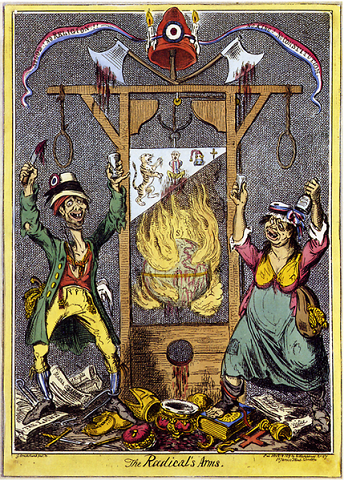
The Reign of Terror:
Social Unrest Turns Ugly
France, 1793-1794
The end of the old order
The old French monarchy had been decadent and out-of-touch with the realities of later-18th-century France for some time. The government ran huge budget deficits and found itself entangled in long, expensive wars overseas to maintain an overstretched empire. The the upper classes lived lives of open luxury and depravity, while the common man grew poorer, hit by famines and high taxes to support the idle, unimaginably wealthy elite. In 1789, the people revolted and the next few years saw uneasy struggle between a monarchy unable to compromise and various left-leaning councils that supposedly represented the will of the people.
In 1792 a Republic was declared, and the French King Louis XVI was executed in 1793. In an effort ostensibly to prevent chaos, Maximilien Robespierre and the radical Jacobin group assumed control over the Committee of Public Safety, setting the stage for the reign of terror to run 1793 until 1794.
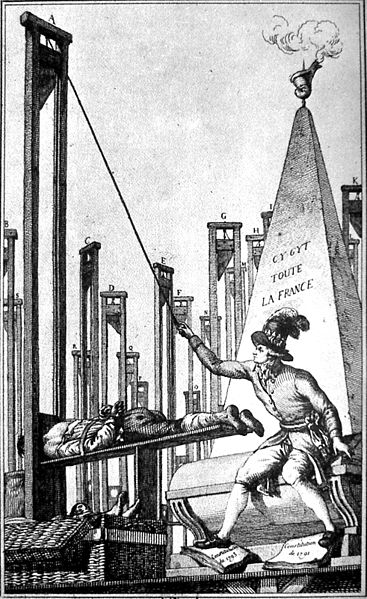
Above: (Satirical cartoon): Robespierre executes the last executioner, the final man alive besides himself in France, after the Terror has turned the country into a forest of silent guillotines.
As with all complex historical phenomena, the causes of the terror were multiple.
“Public Safety:”
People were afraid and gave into fear after the end of the old government. The “Committee on Public Safety” was initially just supposed to keep people safe. But it began to terrorize the population. The new politicians jumped to denounce their rivals as secret enemies of the revolution, so they’d be executed and clear the way. Suddenly everyone was denouncing everyone else before they got denounced themselves. Neighbors denounced each other over laundry-line disputes, or because somebody made a joke, or used an old word for things instead of the new, “politically correct” terminology. It was safer to seem like a real rebel yourself and denounce other people than wait to be denounced yourself, so everybody jumped to point fingers. The denuncees were given a quick trial, had their heads shaved, and then met the guillotine and lost their skulls.
I guess people felt nervous about public safety. Never know when a friend or neighbor could turn out to secretly be a terrorist or counterrevolutionary deserving of beheading.
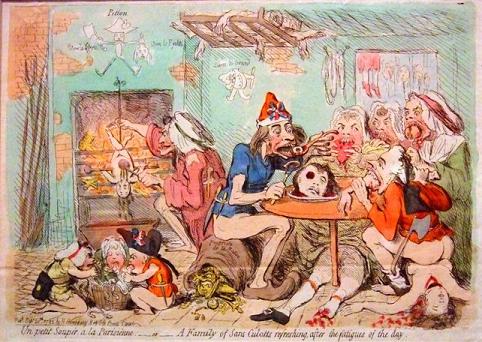
Above: A Sans-Coulette family feasts on human bodyparts after a long day of slaughter (satirical cartoon)

Above: A romantic image of a Sans-Coulette.
The Sans-Coulettes
The Sans-Coulettes (“without stockings”) was the name given to the most ultra-radical, ultra-revolutionary faction. Their ranks were filled with some of Paris’s poorest and most miserable: Illiterate, barefoot beggars and gutter-dwellers, pimps and prostitutes, freed convicts from prisons that had simply had the doors opened wide one day, mercenaries from Southern France. They would clog into legal buildings and create chaotic scenes by whooping, cheering, making noise, or drowning out the opposition in debate with screeching and nonsense. Think of them as a pack of anonymous trolls, perhaps. Many politicians throught they could lead the Sans-Coulettes, but these politicos usually ended up getting their heads cut off. The Sans-Coulettes howled for blood, prowled the streets creating violence, and generally represented the most violent, insurrectionary elements of society. If you stood up and criticized their nihilistic line, however, you would be condemned as a “counter-revolutionary” and promptly executed.
In politics, for a long time the most extreme radicals were the so-called “Hébertist faction.” .Historian Simon Schama describes their ideology as follows: "an anarchic notion of popular government, always armed to impose the will of the people on its mandatories [and took the form of support for] unrelenting surveillance, denunciation, indictment, humiliation, and death.”
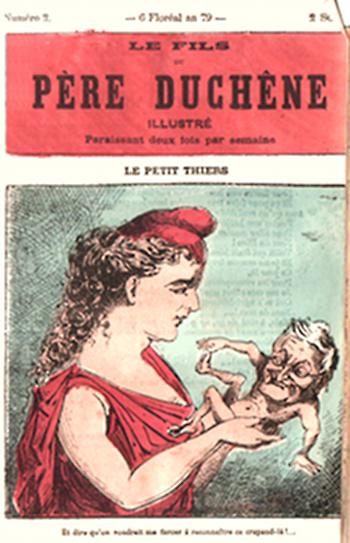
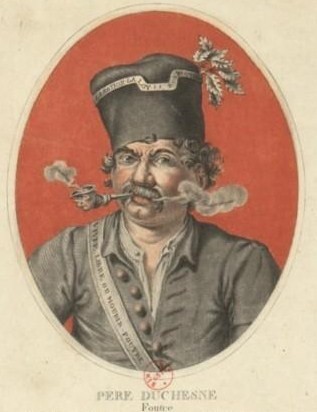
Above: The character Pere Duchense
Inflammitory messages were spread by new types of cheaply produced broadsides and other media. Mascots like the cartoon character Pere Duchanse (above) spweed crude and violent material, often naming names that quickly became targeted for instant death. A typical article title was “F*** the Pope,” and it called for the elimination of all religion, enforced atheism, and voting rights that would be limited to the Sans-Coulettes. It called for execution of “toads” using euphemisms like, "to sneeze in the bag", "to ask the time from the fanlight", "to try on Capet's neckte."
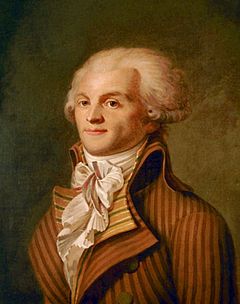

Above: Robspierre (top) and his dramatic arrest in public (below), which ended the chaos
On 5 February 1794 Robespierre stated: "Terror is nothing else than justice, prompt, severe, inflexible.” He claimed “The government in a revolution is the despotism of liberty against tyranny.” Robespierre thought he was the mastermind of the terror, using the hysterical climate to denounce anyone who gave him even the slightest degree of negativity. However, eventurally the madness engulfed him, too, and his own execution in July 1794 marked the end of the terror. As the paranoia wound down, the people of France cautiously began to live life as normal again without the need for hysterical renunciation of foes, and slowly the new republic came to seem saner and safer.
edit on 5/25/2012 by silent thunder because: (no reason given)
new topics
-
Gaza Terrorists Attack US Humanitarian Pier During Construction
Middle East Issues: 25 minutes ago -
The functionality of boldening and italics is clunky and no post char limit warning?
ATS Freshman's Forum: 1 hours ago -
Meadows, Giuliani Among 11 Indicted in Arizona in Latest 2020 Election Subversion Case
Mainstream News: 2 hours ago -
Massachusetts Drag Queen Leads Young Kids in Free Palestine Chant
Social Issues and Civil Unrest: 2 hours ago -
Weinstein's conviction overturned
Mainstream News: 3 hours ago -
Supreme Court Oral Arguments 4.25.2024 - Are PRESIDENTS IMMUNE From Later Being Prosecuted.
Above Politics: 5 hours ago -
Krystalnacht on today's most elite Universities?
Social Issues and Civil Unrest: 5 hours ago -
Chris Christie Wishes Death Upon Trump and Ramaswamy
Politicians & People: 5 hours ago -
University of Texas Instantly Shuts Down Anti Israel Protests
Education and Media: 7 hours ago -
Any one suspicious of fever promotions events, major investor Goldman Sachs card only.
The Gray Area: 10 hours ago
2
